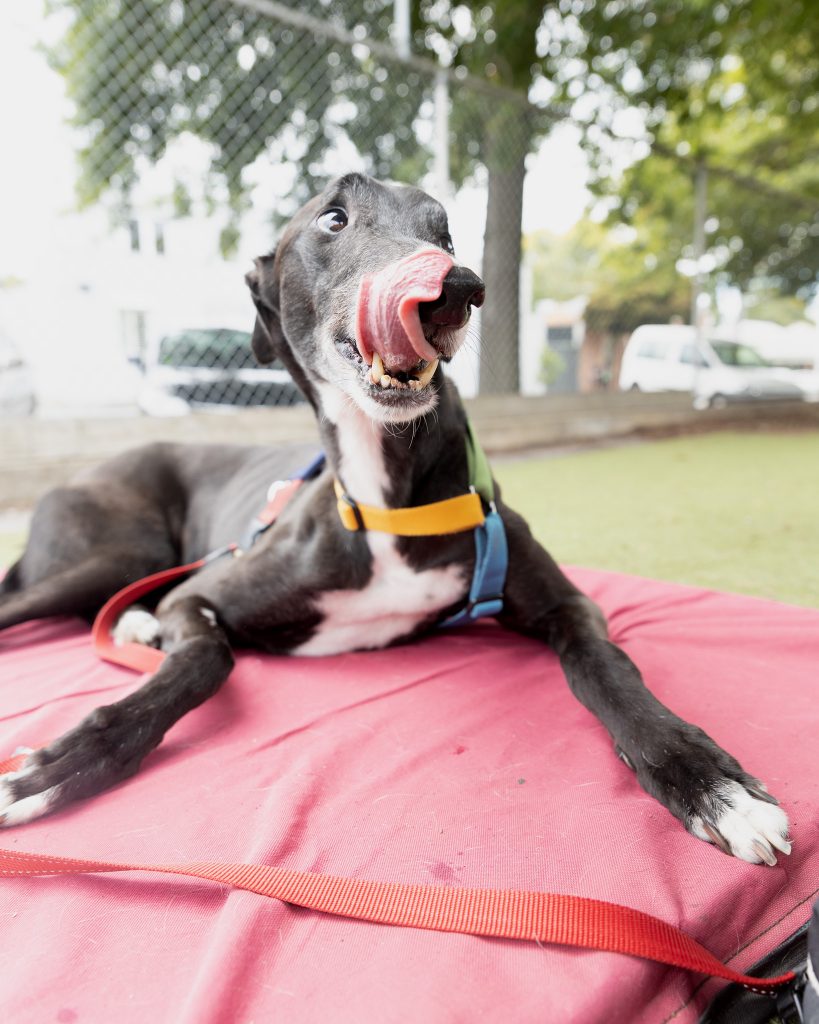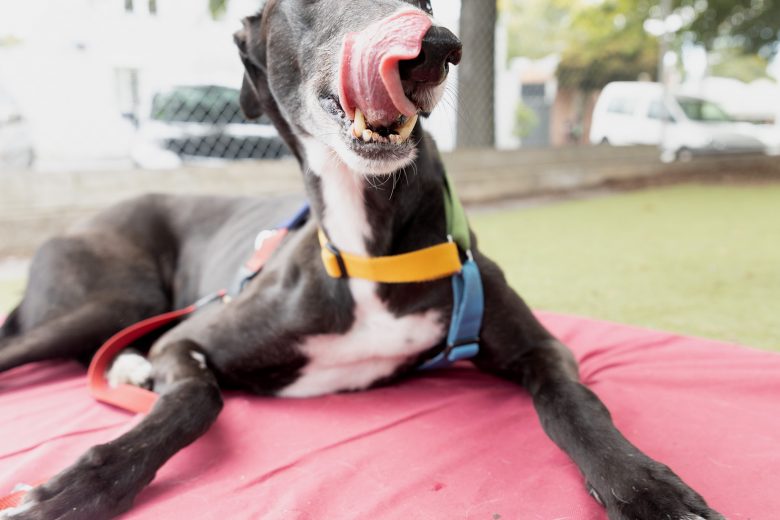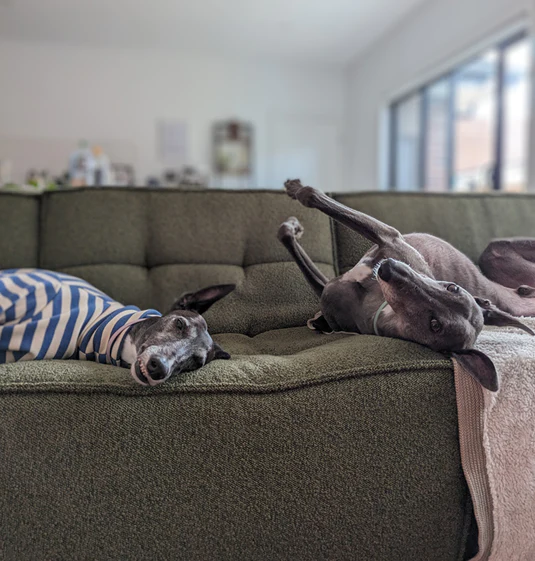Gumtree Greys’ Director and certified behaviour consultant Julia Cockram breaks down the importance of understanding dog body language, the meaning behind common signals, and the importance of context.
As a certified behaviour consultant, I’m often asked what the most important thing to learn is when it comes to our dogs. My answer is that learning to read what your dog is communicating through their body language is vital for understanding their behaviour.
Let’s break down the different components of dog body language.
How do dogs communicate with body language?
In layman’s terms, most body language fits into the following categories:
- Relaxed
- Fearful
- Anxious
- Excited
- Aggressive
The complicated part of understanding canine body language is that most communication combines more than one of these categories. When we look at our dog’s body language, we need to take into consideration the context — what the dog is doing, what’s occurring in their environment and the personality of the dog.
Our ability to read our dog’s body language is complicated even further by common misconceptions about canine communication that stem from outdated and incorrect ideas like dominance theory. Our tendency as humans to anthropomorphise our dogs (map human emotions and concepts onto animal behaviours) also doesn’t help!
Thankfully, by recognising stressed dog body language, we can make sure our dogs don’t feel the need to escalate to a growl, bark, lunge or bite, and anticipate situations where they feel uncomfortable or stressed. Once we learn to speak our dog’s language, we can better understand why they react a particular way in a situation and we can anticipate future behaviour more accurately.
What does relaxed dog body language look like?
It’s important to understand when your dog is relaxed, as this is a good sign that they are enjoying the current interaction or situation. Some of the behaviours that indicate your dog is relaxed are:
- Open mouth with tongue lolling out
- Loose, relaxed body
- Relaxed facial muscles
- Soft eyes (can look squinty)
- Tail is wagging softly and wide at mid height.
Why do dogs use calming signals?
Dogs learn from a young age to avoid conflict with dogs and humans, and to release stress using calming signals. These can also be called appeasement or diffusing signals, as they can help defuse stressful or threatening situations and prevent escalation.
Displacement behaviours help dogs express and resolve their internal conflict when they feel uncertain or anxious.
Dogs display calming signals and displacement behaviours when they are feeling fearful, anxious or stressed. Let’s unpack some examples of these behaviours.
Calming, appeasing and diffusing signals
- Slow movement can be an appeasement behaviour when a dog is fearful or stressed. It can also be a stalking behaviour, so it’s important to take the environment into consideration.
- Stiffening or freezing is a clear sign that something is wrong and is often paired with alert ears, closed mouth and wide eyes.
- Sitting or lying and exposing their belly is an appeasement signal that shows a dog is fearful and trying to de-escalate a situation, not necessarily a request for belly rubs.
- Turning their head away, averting their gaze or avoiding eye contact is a way for dogs to show discomfort..
- Whale eye, where a dog’s eyes are large, open and showing the whites is another form of looking away. Whale eye often occurs with a head or body turn and may indicate fear or discomfort, and can be a sign that the dog may escalate.
- A tightly closed mouth, or clenched jaw, can mean a dog may be distrustful of something in their environment.
- Cowering or a lowered body indicates that a dog is trying to make themselves look smaller and they may be anxious or fearful.
- Tucked tail, where a dog tucks their tail between their legs, may be a sign of anxiety.
- A curved, erect tail may be a sign that the dog feels threatened and may escalate into aggression. The dog’s tail may be stiff or wagging, but is held high.
- Raised fur on the back and/or neck is called piloerection. It means the dog is on high alert and may feel threatened.
- Ears forward shows alertness. The dog is at attention and could spill into aggression if the situation is not diffused.
- Furrowed brow, curled lips and wrinkling nose are signs that the dog is threatened and could escalate to aggressive behaviour.
- A paw lift can indicate unease or discomfort and is a way for a dog to communicate that they are not a threat.
- Trembling or shaking can be signs your dog is scared or stressed.
- A full body stretch may be a way to diffuse tension.
Displacement signals
- Blinking more quickly than usual.
- Nose or lip licks, outside of eating, are a sign of discomfort, anxiety or stress. The dog may lick their lips or nose once or multiple times.
- Sudden ground sniffing or full body shake-offs are displacement behaviours to reduce tension. They may indicate that a dog needs a break when meeting other dogs, and to indicate to them that they are uncomfortable.
- Yawning is a way that a dog can try to relieve their stress. Since it is also a way for dogs to communicate that they are uncomfortable, yawning can be an appeasement or displacement behaviour.
- Sudden licking or scratching can be displacement signals that indicate a dog is trying to relieve tension or stress. They could also be signs of pain or discomfort.

Interpreting dog body language in context
With so many actions and signs that are often very subtle, It’s important to take in the dog’s body language as a whole combined with the context when evaluating what your dog is trying to communicate.
If your dog licks their lips multiple times when a camera is put in front of their face, they may be saying “I feel a little uncomfortable.” If their body is loose and eyes are soft, they aren’t likely to escalate. On the other hand, if your dog is meeting another dog in the park and is licking their lips, has a stiff body, and is averting their gaze, they may be more likely to escalate to aggression if they’re forced to stay in close proximity to the other dog and don’t get the space they’re asking for.
You also need to take into account factors like whether your dog is restrained or able to move away from the situation, whether they know how to remove themself from uncomfortable situations, if high value resources like a bed, toy or food are nearby or whether children are crowding your dog. Understanding your dog’s individual response to environmental factors like these, helps you to see the full picture of their body language.
Wrapping up
You don’t have to be an expert right away, but being able to read the signs that your dog uses to communicate excitement, relaxation, fear or anxiety and reacting appropriately teaches your dog that you’re listening and that they don’t need to escalate to louder or more intense forms of communication. That’s great news for your peace of mind, your dog’s wellbeing, and your bond with each other!
dog body language learning about your greyhound rescue greyhound
Last modified: April 22, 2024







